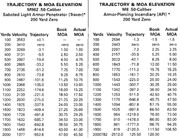| "This weapon isn't functioning properly! Send it back to the armory and perform the necessary repairs to make it functional again."
This article needs to be cleaned up and brought up to Gun Wiki standards. |

SLAP Polymer Sabot
The sabot light armor penetrator, also known as the SLAP round, is a round made for penetrating higher-level armor that normal armour-piercing rounds cannot get through. It has a polymer sabot (sometimes called a 'shoe') which allows the use of the tungsten carbide penetrator which is smaller than the original bore.
It is fired from the M2 machine gun and modern tanks, and is mainly used in anti-armor roles against APCs and helicopters. It is also compatible with the M2 machine gun on the Bushmaster and can safely be used in unmodified machine guns.
The SLAP round is now being developed by Winchester as they recently scored a $43 million contract.
Unfortunately, it does not fire accurately through bolt-action sniper rifles and is prohibited from being fired through the M107.
"The downside is that the SLAP round is not compatible with some rifles because its greater length will not allow it to chamber or can cause damage to the throat. I've also heard stories of plastic sabot bits gumming up muzzle brakes or being blown back on spotters. The bottom line: before firing SLAP ammo in your rifle, know for certain that it fits your chamber and is not a hazard to fire." - The Ultimate Sniper.
The calculation of using a lightweight cartridge plus a lightweight projectile means added velocity. The plastic shoe is discarded once the round is fired and the SLAP round travels at more than 4,000 feet per second to penetrate armor, using its tungsten carbide penetrator. Its tip is also very pointed and sharp adding for better penetration.
It maximizes the engagement range and effectiveness on target.

The Ultimate Sniper
Description[]
The Sabot Light Armor Penetrator with Tracer (SLAP-T), M962 cartridge consists of a tungsten alloy penetrator of the same mass as the Saboted Light Armor Penetrator (SLAP), M903 is sabot launched at a much higher velocity than standard rounds. The sabot, which is designed to break up at the muzzle to release the penetrator, must also survive the gun environment until launch. It is injection moulded of special high strength plastic and is reinforced with an aluminium insert in the base section. The tungsten alloy penetrator has a slot in the base to ensure full spin-up before separation from the sabot at the muzzle. The penetrator base is cored out to accommodate a trace mix composition. This ammunition is for use in subcalibre devices for tank training. The item is Code "A", approved for service use.
Calibers[]
- 7.62 NATO - M948(SLAP) and M959 (SLAP-T)
- .50 BMG - M903(SLAP) and M962(SLAP-T)
- 14.5x114mm - DGJ-02 (SLAP-T)
Features[]
.50 caliber SLAP ammunition was developed by the Marine Corps during the mid/late 1980s and was approved for service use in 1990 during Operation Desert Storm. It uses a reduced caliber, heavy metal (tungsten) .30 inch diameter penetrator wrapped in a "plastic" sabot or "shoe" of .50 inch diameter.
Since the mass of the sabot penetrator is much lighter in weight than normal ball .50 caliber ammunition, SLAP's velocity can be significantly and safely increased in an unmodified M2 Machine Gun. This produces a very fast round with a very flat trajectory which enhances hit probability. SLAP ammunition is completely interoperable with M2 machine guns with stellite liner. It has a maximum effective range of around 1,500m.

SLAP
Background[]
During the 1980s, the Marine Corps invested in both .50 caliber and 7.62 x 51 SLAP concepts. The .50 caliber effort was very successful and extends the light armor capability of the M2 Heavy Machine Gun significantly. The 7.62mm effort was not successful in the M60 and caused catastrophic barrel failures due to in-bore break-up of the sabot and the penetrator puncturing the side of the barrel. Also, its increase in penetration was not on the same order of magnitude as the .50 caliber SLAPs.
It was used with great success in the First Gulf War, taking out APCs.
Data[]
- Velocity: 3985 feet per second
- Cost: $7.50 per round making it cheaper than the MK211
- Maximum effective range: 4921.5 feet (1500 meters) against 3/4" High Hard Armor (HHA)
- Can penetrate 34mm of hardened armor at 500 meters